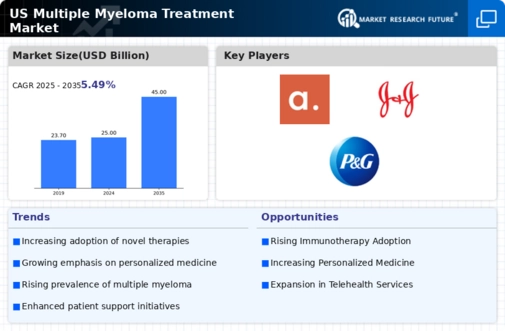The US Multiple Myeloma Treatment Market is characterized by a vibrant landscape of innovation where several pharmaceutical companies compete to develop therapies for this complex and often challenging disease. Multiple myeloma, being a hematological malignancy, has attracted a diverse array of treatments aimed at the various stages and aspects of the disease. The competitive landscape is marked by rapid advancements in drug formulations, including monoclonal antibodies and targeted therapies, along with a convergence of clinical trials that foster substantial opportunities for growth and differentiation among players.
Understanding the competitive dynamics among market participants is crucial for stakeholders seeking to navigate this environment effectively, especially as treatments evolve and new entrants emerge.Celgene has established itself as a leading force in the US Multiple Myeloma Treatment Market. Known for its innovative approaches and state-of-the-art therapies, the company has developed several key products that have significantly impacted patient care. Celgene's strengths lie in its robust research and development capabilities, which keep it at the forefront of medical advancements in multiple myeloma.
The firm focuses on personalized medicine, ensuring its therapies are tailored to meet the unique needs of individual patients. Additionally, Celgene has a strong market presence backed by strategic collaborations and partnerships that enhance its product offerings and expand its reach within the US healthcare system. Its existing alliances with various academic institutions and research organizations further strengthen its position by facilitating continued exploration into novel treatment avenues.
Takeda plays a vital role in the US Multiple Myeloma Treatment Market, exhibiting a broad portfolio of therapies tailored to combat this disease. The company is recognized for its comprehensive understanding of multiple myeloma and has developed several key products that cater to different treatment phases. Takeda's strength lies in its commitment to innovative drug discovery, coupled with a focus on real-world evidence that supports the efficacy and safety of its therapies. The company's market presence is significantly bolstered by its strategic acquisitions, which have enabled it to expand its capabilities and offerings in the field of hematology.
With a proactive approach to mergers and collaborations, Takeda constantly seeks opportunities to enhance its product pipeline, which augments its standing in the competitive landscape of multiple myeloma treatment in the US. The company's emphasis on patient-centered care and advocacy initiatives further align it with the needs of healthcare providers and patients, solidifying its reputation within the market segment.














Leave a Comment